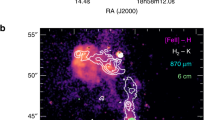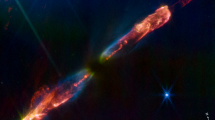Abstract
Young stars are thought to accumulate most of their mass through an accretion disk, which channels the gas and dust of a collapsing cloud onto the central protostellar object1. The rotational and magnetic forces in the star–disk system often produce high-velocity jets of outflowing gas2,3,4,5,6. These jets can in principle be used to study the accretion and ejection history of the system, which is hidden from direct view by the dust and dense gas of the parent cloud. But the structures of these jets are often too complex to determine which features arise at the source and which are the result of subsequent interactions with the surrounding gas. Here we present infrared observations of a very young jet driven by an invisible protostar in the vicinity of the Horsehead nebula in Orion. These observations reveal a sequence of geyser-like eruptions occurring at quasi-regular intervals and with near-perfect mirror symmetry either side of the source. This symmetry is strong evidence that such features must be associated with the formation of the jet, probably related to recurrent or even chaotic instabilities in the accretion disk.
This is a preview of subscription content, access via your institution
Access options
Subscribe to this journal
Receive 51 print issues and online access
$199.00 per year
only $3.90 per issue
Buy this article
- Purchase on Springer Link
- Instant access to full article PDF
Prices may be subject to local taxes which are calculated during checkout


Similar content being viewed by others
References
Beckwith, S. V. W. & Sargent, A. I. Circumstellar disks and the search for neighbouring planetary systems. Nature 383, 139–144 (1996).
Camenzind, M. in Herbig-Haro Flows and the Birth of Low Mass Stars(eds Reipurth, B. & Bertout, C.) 241–258 (Proc. IAU Symp. 182, Kluwer, Dordrecht, (1997)).
Shu, F. H. & Shang, H. in Herbig-Haro Flows and the Birth of Low Mass Stars(eds Reipurth, B. & Bertout, C.) 225–239 (Proc. IAU Symp. 182, Kluwer, Dordrecht, (1997)).
Ouyed, R., Pudritz, R. E. & Stone, J. M. Episodic jets from black holes and protostars. Nature 385, 409–414 (1997).
Edwards, S., Ray, T. & Mundt, R. in Protostars and Planets III(eds Levy, E. H. & Lunine, J. L.) 567–602 (Univ. Arizona Press, Tucson, (1993)).
Bachiller, R. Bipolar molecular outflows from young stars and protostars. Annu. Rev. Astron. Astrophys. 34, 111–154 (1996).
Wouterloot, J. G. A. & Walmsley, C. M. H2O masers associated with IRAS sources in regions of star formation. Astron. Astrophys. 168, 237–247 (1986).
Zinnecker, H., Bastien, P., Arcoragi, J.-P. & Yorke, H. W. Submillimeter dust continuum observations of three low luminosity protostellar IRAS sources. Astron. Astrophys. 265, 726–732 (1992).
Chini, R. et al. Cold dust around Herbig-Haro energy sources: morphology and new protostellar candidates. Astron. Astrophys. 32/b>, 542–550 (1997).
Wouterloot, J. G. A., Henkel, C. & Walmsley, C. M. CO observations of IRAS sources in Orion and Cepheus. Astron. Astrophys. 215, 131–146 (1989).
Claussen, M. J., Marvel, K. B., Wootten, H. A. & Wilking, B. A. in Herbig-Haro Flows and the Birth of Low Mass Stars(eds Reipurth, B. & Bertout, C.) 515–524 (Proc. IAU Symp. 182, Kluwer, Dordrecht, (1997)).
Zinnecker, H. in Low-mass Star Formation and Pre-main Sequence Objects(ed. Reipurth, B.) 447–469 (Proc. ESO Workshop, European Southern Observatory, Garching, (1989)).
Reipurth, B. Ageneral catalog of Herbig-Haro objects. Available by anonymous ftp, directory pub/Catalogs/Herbig-Haro from 〈ftp.eso.org〉((1994)).
McCaughrean, M. J., Rayner, J. T. & Zinnecker, H. Discovery of a molecular hydrogen jet near IC348. Astrophys. J. 436, L189–L192 (1994).
Rodríguez, L. F. & Reipurth, B. VLA detection of the exciting sources of HH24, HH114, and HH199. Rev. Mex. Astron. Astrofis. 32, 27–33 (1996).
Hirth, G., Mundt, R., Solf, J. & Ray, T. P. Asymmetries in bipolar jets from young stars. Astrophys. J. 427, L99–L102 (1994).
Fendt, C. & Camenzind, M. On collimated stellar jet magnetospheres. II. Dynamical structure of collimating wind flows. Astron. Astrophys. 313, 591–604 (1996).
Burrows, C. J. et al. Hubble Space Telescope observations of the disk and jet of HH30. Astrophys. J. 473, 437–451 (1996).
Heathcote, S. et al. Hubble Space Telescope observations of the HH47 jet: narrowband images. Astron. J. 112, 1141–1168 (1996).
Reipurth, B. The HH111 jet and multiple outflow episodes from young stars. Nature 340, 42–45 (1989).
Gredel, R. & Reipurth, B. An infrared counter-flow in the HH111 jet complex. Astron. Astrophys. 289, L19–L22 (1994).
Bell, K. R. & Lin, D. N. C. Using FU Orionis outbursts to constrain self-regulated protostellar disk models. Astrophys. J. 427, 987–1004 (1994).
Balbus, S. A. & Hawley, J. F. Instability, turbulence, and enhanced transport in accretion disks. Rev. Mod. Phys. 70, 1–54 (1998).
Stone, J. M. & Norman, M. L. Numerical simulations of protostellar jets with nonequilibrium cooling. II. Models of pulsed jets. Astrophys. J. 413, 210–220 (1993).
Raga, A. C. & Kofman, L. Knots in stellar jets from time-dependent sources. Astrophys. J. 386, 222–228 (1992).
Suttner, G., Smith, M. D., Yorke, H. W. & Zinnecker, H. Multi-dimensional numerical simulations of molecular jets. Astron. Astrophys. 318, 595–607 (1997).
Reipurth, B., Bally, J. & Devine, D. Giant Herbig-Haro flows. Astron. J. 114, 2708–2735 (1997).
van der Klis, M. Quasi-periodic oscillations and noise in low-mass X-ray binaries. Annu. Rev. Astron. Astrophys. 27, 517–553 (1989).
McHardy, I. & Czerny, B. Fractal X-ray time variability and spectral invariance of the Seyfert galaxy NGC5506. Nature 325, 696–698 (1987).
Smith, M. D. & Brand, P. W. J. L. H2profiles of C-type bow shocks. Mon. Not. R. Astron. Soc. 245, 108–118 (1990).
Smith, M. D., Brand, P. W. J. L. & Moorhouse, A. Shock absorbers in bipolar outflows. Mon. Not. R. Astron. Soc. 248, 730–740 (1991).
Ray, T. P. et al. Large-scale magnetic fields in the outflow from the young stellar object T Taui S. Nature 385, 415–417 (1997).
Mirabel, I. F. & Rodríguez, L. F. Asuperluminal source in the galaxy. Nature 371, 46–48 (1994).
Zensus, J. A. Parsec-scale jets in extragalactic radio sources. Annu. Rev. Astron. Astrophys. 35, 605–636 (1997).
Herbst, T. M. et al. in Infrared Detectors and Instrumentation(ed. Fowler, A. M.) Proc. SPIE 1946, 605–609 (1993).
Smith, M. D. Predictions for JHK photometry of molecular shocks. Astron. Astrophys. 296, 789–796 (1995).
Hodapp, K.-W., Hora, J. L., Erwin, E. & Young, T. KSPEC—a near infrared cross-dispersed spectrograph. Publ. Astron. Soc. Pacif. 106, 87–93 (1994).
Smith, M. D., Davis, C. J. & Lioure, A. The ortho and para fractions of molecular hydrogen in protostellar outflows and Herbig-Haro objects. Astron. Astrophys. 327, 1206–1214 (1997).
Herbst, T. M. et al. Anear-infrared spectral imaging study of T Tau. Astron. J. 111, 2403–2414 (1996).
Greene, T. P., Tokunaga, A. T., Toomey, D. W. & Carr, J. S. in Infrared Detectors and Instrumentation(ed. Fowler, A. M.) Proc. SPIE 1946, 313–324 (1993).
Acknowledgements
We thank S. Balbus, J. Bally, R. Blandford, W. Brandner, M. Camenzind, W. Dent, C.Fendt, R. Gredel, G. Hasinger, L. Kofman, R. Mundt, M. Norman, M. Rees, B. Reipurth, M. Smith, F.Shu, J. Stone, C. Terquem, M. Walmsley and H. Yorke for discussions on the theory and observations of astrophysical jets. We also thank C. Ishida for reducing the KSPEC data. H.Z. and M.J.M. were visiting astronomers at the NASA IRTF using the facility camera NSFCAM, with which HH212 was originally discovered.
Author information
Authors and Affiliations
Corresponding author
Rights and permissions
About this article
Cite this article
Zinnecker, H., McCaughrean, M. & Rayner, J. A symmetrically pulsed jet of gas from an invisible protostar in Orion. Nature 394, 862–865 (1998). https://doi.org/10.1038/29716
Received:
Accepted:
Issue Date:
DOI: https://doi.org/10.1038/29716
This article is cited by
-
Molecular jets from low-mass young protostellar objects
The Astronomy and Astrophysics Review (2020)
-
A rotating protostellar jet launched from the innermost disk of HH 212
Nature Astronomy (2017)
-
Disks and Jets
Space Science Reviews (2015)
-
How Produce a Plasma Jet Using a Single and Low Energy Laser Beam
Astrophysics and Space Science (2007)
-
Jets from young stars
Astrophysics and Space Science (2007)
Comments
By submitting a comment you agree to abide by our Terms and Community Guidelines. If you find something abusive or that does not comply with our terms or guidelines please flag it as inappropriate.



